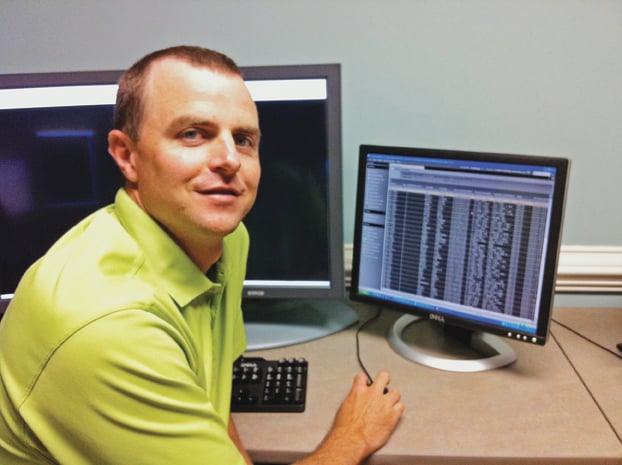
Michael Brown, M.D., said his radiology group needed an integrated RIS/PACS in order to obtain the necessary efficiencies to serve its diverse client base.
Efficient sharing of data and images is essential for multi-site healthcare systems and radiology groups that read for multiple sites or facilities. In today’s world of consolidation, that represents the majority of radiology service providers.
Our group, Carolina Radiology Associates in Myrtle Beach, S.C., consists of 18 radiologists with subspecialty training in neuroradiology, musculoskeletal radiology, vascular/interventional radiology, body imaging and nuclear medicine. We provide on-site radiology services for hospitals and imaging centers and teleradiology services for various clinicians’ in-office imaging and for multiple urgent care practices. Radiologists at our main office conduct after-hours and weekend reading for hospitals and urgent care centers and daytime teleradiology services for oncology, urology and orthopedic practices.
About 20 percent of our imaging volume is read through our teleradiology contracts, with the remaining 80 percent devoted to hospital-based services. Our radiologists rotate working at different locations to build relationships with the physicians we serve and to demonstrate our support for those physicians and their patients. We provide after-hours reading to demonstrate our commitment to our clients.
Like many radiology groups, we had remained stagnant with our picture archiving and communication system (PACS) and information technology (IT) infrastructure as our business grew. Ultimately, our group found itself needing to increase its efficiency to deliver rapid reports to our various clients.
For example, our previous workflow required more than 20 mouse clicks to provide reports to our urgent care centers. We had to decrease such manual actions by technologists and create a seamless integration with various electronic medical record (EMR) systems.
When it came time to replace our PACS, we developed an eight-point checklist for what we wanted:
• A Web-based PACS platform to provide affordability and flexibility;
• smooth interface with multiple vendors’ radiology information systems (RIS)/PACS to communicate patient data, images and reports efficiently;
• global worklist for all client facilities;
• ability to integrate data with our clients’ EMR systems;
• integrated voice recognition;
• configurable hanging protocols;
• automatic pulling of prior exams; and
• automatic registration of prior and current 3-D exams.
As we evaluated suppliers and conducted on-site demonstrations with several PACS vendors, we realized we needed an integrated RIS/PACS platform to accomplish all our goals. We chose Carestream’s Vue RIS+PACS+Reporting solution, opting for its native voice recognition, which is fully featured and more affordable than integrating a third-party VR system.
Faster Reporting, Integration with EMRs
Imaging services providers require responsive reporting. Our new technology equips us to speed report times and improve our efficiency, reading workflow and convenience. The foundation of our workflow is a RIS/PACS that lets us automatically receive patient information and prior exams, read each imaging study and automatically transmit the report to the appropriate provider’s RIS. The new RIS/PACS platform communicates smoothly with different vendors’ RIS and PACS at all the locations we serve.
The system also goes a step further, creating a global patient worklist that equips our radiologists to read urgent exams first, followed by exams in their specialty and then general reading. This expedites reporting because all our radiologists, regardless of their location, can read exams from the list. Our practice can fully utilize all our radiologists, so we can deliver more responsive service to our clients.
We can offer rapid turnaround times for urgent studies and provide final reports to clinicians, even after-hours. Routine reports are issued within hours, utilizing medical editor support along with the integrated voice recognition software. We also can populate data fields into each facility’s EMR system, which represents the next generation of data sharing.
Radiologists Gain Efficiency, Convenience
Integrated voice recognition improves productivity, and our radiologists enjoy access to advanced tools that enable faster reading and greater accuracy. Configurable hanging protocols and automatic pulling of prior exams from each site’s RIS are tremendous timesavers and eliminate our previous need to call facilities when prior exams were missing.
Our PACS offers an advanced tool that provides automatic registration of prior and current 3-D exams, including computed tomography (CT), magnetic resonance (MR) and positron emission tomography (PET). This is a huge advantage when measuring tumors and tracking disease states. Native MPR and MIP tools help provide accurate, real-time evaluation of the datasets and eliminate the need to depend on technologists for reconstructed images.
Today, we are able to establish stronger relationships with clients by integrating our reports with their EMR systems and by adapting the format of our reports to address their specific needs. The bottom line is we have achieved a workflow that delivers quality and speed, allowing us to deliver enhanced support to the facilities we serve.
Michael Brown, M.D., is a radiologist with Carolina Radiology Associates in Myrtle Beach, S.C.


 December 10, 2025
December 10, 2025 









